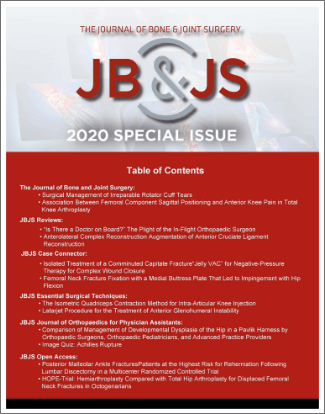


While the Making History Together timeline is, by its very nature, a look back in time, we hope that it also serves as an inspiration for the future of orthopaedic surgery and your individual career.
If you are just entering the field of orthopaedics, welcome to the JBJS community. Know that you can count on JBJS to serve you through the end of your schooling and throughout your residency with trusted insights and education that will give you the confidence you need to treat patients using the latest evidence-based approaches. If you are currently a practicing surgeon, we are pleased to provide the guidance you need to excel in an evolving field and the practical information you need to meet and maintain CME/MOC requirements.
JBJS will continue to follow the evolving science of orthopaedics as we have in the past. Back in the 1960s, we published the first articles about the use of arthroscopy. Today, arthroscopy and other minimally invasive and image-guided surgical techniques are the norm and represent a trend that will continue for the foreseeable future. Let’s all plan to check back here in 10 to 15 years to see if anyone is still using open approaches to treat tibial plateau fractures or tibial pilon fractures.
We will continue to watch computer-assisted surgical techniques and pharmacological interventions to evaluate their relative value in improving patient outcomes. Additionally, we know that we will face new challenges as the field of medicine advances and allows the human lifespan to increase. Will there come a day when a surgeon needs to treat a 110-year-old man who has had a joint replacement revised three times?
Proteomics and genomics will soon start to play a larger role in orthopaedics, and JBJS expects to see an increase in manuscript submissions relating to targeted therapies. We also expect to see an increase in manuscripts on issues relating to rare diseases and conditions, and we are working to enhance JBJS Case Connector to make it easier for surgeons to search for information about treatment approaches and outcomes for conditions they may only see once in a 30-year career.
From a scholarly publishing perspective, the prevalence and creative use of multicentered randomized controlled trials will grow and become more influential. At the same time, cohort studies will continue to be essential for our broad-based field.
JBJS expects the current trend of improvements in research methodology to continue. We also expect to increase our reliance on reviewers with expertise in statistics and epidemiology as electronic medical records offer new access to patient data and analytical approaches become even more sophisticated. Patient-reported outcome measures will also grow in importance, and orthopaedists will need to optimize the ways in which we incentivize patients to provide those data.
Predicting the future of health care in general and orthopaedics in particular can be a dicey proposition. So much of the way in which health care is delivered in the U.S. is driven by factors that are beyond the control of the individual orthopaedist.
For example, the traditional fee-for-service approach has gradually been replaced by a value-based approach. Indeed, JBJS has recently seen an explosion in manuscripts focused on “value” as part of a cost-effectiveness analysis. Now, the U.S. is addressing the very real proposition of some form of universal health care. How will that development impact orthopaedic surgeons (beyond cutting down on insurance paperwork and the cost of overhead)? Although the future is unpredictable, JBJS will always be there to help orthopaedists make sense of it all.
At JBJS, we believe that what orthopaedists do matters to patients and that orthopaedic surgery will continue to be an exciting field and career. It’s one of the few specialties in which practitioners have the opportunity to create long-term relationships with their patients, get to know them as people, and truly improve their quality of life.
Everyone at JBJS is honored to continue contributing to patient well-being. We are indeed fortunate to have this privilege.

Sign up to receive your free JBJS 2020 Special Issue—a compilation of the most-read articles. You get twelve articles across six JBJS publications in this special issue.